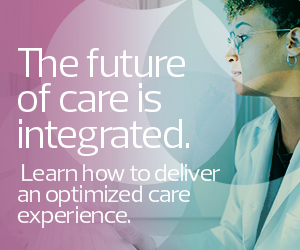Clinicians and consumers remain hopeful about a future of healthcare that is more personalized and personable, collaborative, and mindful of both provider and patient needs.
Recent GE HealthCare research identified six trends driving healthcare transformation: the well-being of care teams; patient and provider partnership; smart technologies; harnessing the power of Big Data; distributed care; and predictive, preventive and precision medicine.
Even amid staffing and financial constraints, healthcare organizations across the U.S. continue to find ways to support innovation and move toward better care delivery methods.
Virtual care programs, for example, have come a long way, and health systems can now offer more robust services with a quicker rollout process. Houston Methodist is one healthcare organization that keeps innovation at the forefront, sharing its experiences around quickly standing up virtual nursing and integrating remote patient monitoring tools.
“Change management and implementation is always going to be a challenge. With all of this new technology, there are more options and features, and that’s great, but that also means there’s a lot more complexity and nuance to think about in terms of data, privacy and artificial intelligence,” says Dr. Sarah Pletcher, system vice president and executive medical director for strategic innovation at Houston Methodist.
She talked to HealthTech about stakeholder buy-in, being clear on ROI and the top priorities for the future.
Click the banner to discover how health IT solutions can help create an integrated care experience.
HEALTHTECH: How did Houston Methodist come to prioritize and innovate its approach to virtual care? What was your starting point?
PLETCHER: At the start of the pandemic, we needed to make sure that all physicians could pivot to use virtual platforms to deliver their visits. We needed to focus on a massive, warp-speed rollout of care redesign in the hospital environment, the intensive care unit, stroke and psychiatry, for example. Then we moved into monitoring and virtual nursing. Now, we’re moving forward into even bolder care redesign. Initially, it was trying to ensure that we could maintain access and excellent care quality despite the challenges of the pandemic.
HEALTHTECH: Tell us about the start of the journey to launch your virtual nursing program. How did you get buy-in from key stakeholders? How did you adapt to feedback?
PLETCHER: With virtual programs, you may have executive buy-in, but it’s a challenge with your end users. Sometimes it’s the other way around. And sometimes you’re struggling to get buy-in from everyone. It depends. For our program, it was a journey to get executive leadership’s commitment to make the investment and then to settle on an approach for the initial care model. We got input from our end users and married that with what we knew made sense from a strategy scale and an ROI perspective. But as soon as we put that service in front of end users, the buy-in and adoption were lightning fast.
For every health system program, if you’re not expanding and changing, there’s a problem. That’s certainly no different for our virtual programs. Virtual nursing has continued a systemwide rollout, and we’ll be layering in other service offerings as part of the care model. We’ve rolled out remote monitoring for the inpatient setting. We’re looking at leveraging a lot of these teams, tools and platforms to expand to other care areas, such as the home.
EXPLORE: Understand the importance of a clear vision for automation and AI in healthcare.
HEALTHTECH: Amid staffing and budget challenges, how do you keep innovation of care delivery a priority? What advice do you have for other healthcare organizations?
PLETCHER: It seems obvious, but make sure you’re actually doing something practical and useful with your innovation efforts instead of a parade of pilots or one-off playdates with cool toys that somebody saw at a conference. Be clear on an ROI. You may need to make different ROI arguments for the same program depending on your stakeholders.
Start with the knowledge of what you’re trying to achieve and make sure you align your innovation portfolio to the broader system strategy: Are you trying to expand your market? Are you trying to address workforce or cost concerns? Are you trying to enhance quality and safety? Are you trying to recruit and retain? Do you have population health considerations? Make sure that your innovation portfolio is aligned with where you’re going as a system.
HEALTHTECH: What technology and infrastructure considerations did you have in expanding your virtual care offerings? How did you know when to invest in newer solutions or rethink your current resources?
PLETCHER: I don’t think we had any unique infrastructure considerations. With anything you’re trying to do, you want to first shop your closet, or look in the pantry before running to the grocery store. But at the end of the day, if the tools that you have are clunky, unwieldy or going to slow you down in getting to market with something scalable, it’s time to consider finding a new process or tool.
HEALTHTECH: What’s your perspective on the use of artificial intelligence and machine learning in supporting healthcare operations?
PLETCHER: I’m eager for more intelligence in healthcare. If it’s thoughtfully delivered — whether it’s documentation, delivering more insights on patient care and experience, or identifying ways we can optimize service improvement efficiency — there can be many more ways to centralize and automate safety nets. There’s plenty of opportunity, but you have to be clear about what problem you’re trying to solve. It’s a new frontier, so there’s not a huge amount of research available to us in all the areas, but there will be because everyone’s going to go in to figure out ways to leverage these capabilities. It’s definitely an exciting time.
READ MORE: Get the answers to five questions about generative AI in healthcare.
HEALTHTECH: What are some key lessons you’ve learned from the conferences you’ve attended so far this year?
PLETCHER: There’s a lot of noise. There are a lot of people talking loudly and name-dropping a lot. When you really look at the groups getting things done with scale, with impact and with outcomes, they aren’t necessarily the ones talking the loudest. They’re the ones who put in the work to be crisp on their strategy, align their stakeholders, have project planning discipline and put just as much effort in on workflows, protocols, algorithms and process as they do on vendor deals.
HEALTHTECH: What are your top priorities for the next few years?
PLETCHER: We have AI and machine learning baked into all of our central monitoring programs. So, we have teams watching patients, but we’re also leveraging learning to develop algorithms and to be more predictive and proactive versus just having staff watching for things. I’m looking at every opportunity to centralize, virtualize, automate and intelligently refine to give care teams and patients time back and deliver better care. That time can come through a variety of ways. And that may look like video endpoints in every inpatient room, wearable vital-sign devices on every patient or ambient intelligence thoughtfully distributed throughout healthcare settings to give us more insight.











